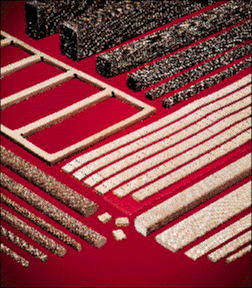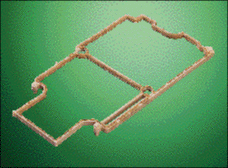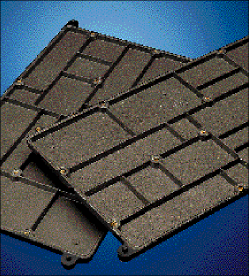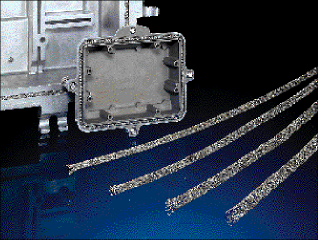Improved shielding
products meet demanding EMI requirements
Lower-cost, easier-to-use gaskets, tapes,
and coatings offer myriad choices for different price, performance,
and application needs
BY NORMAN QUESNEL
Chomerics, Div. of Parker Hannifin
Woburn, MA
With many new electronic products running at higher frequencies in smaller packages, the problem of electromagnetic interference (EMI) is of more concern than ever. Fortunately, an influx of lower-cost, easier-to-use shielding gaskets, tapes, coatings, and other products is keeping pace with the shielding needs of today's electronic products.
The expanding array of EMI shielding products–mostly designed for enclosure-level shielding–offers the design engineer attractive choices in price, performance, and application methods. These products meet the increasingly stringent shielding requirements, both for spurious emissions and immunity, that are set by the FCC and other standards bodies.
Coatings or gaskets
Today, plastic housings and enclosures are often shielded by applying a conductive organic coating on their inner surface. Containing metal particles dispersed in an acrylic or urethane resin, these coatings can be applied using conventional robotic spray systems at a lower cost than plating or vacuum-metallizing processes. Besides providing excellent shielding performance, the best conductive paints also resist abrasion from assembly and handling.
By contrast, metal or metallized-plastic housings are typically outfitted with EMI gaskets to prevent emissions at seams and joints susceptible to leakage, including covers, doors, I/O panels, expansion slots, and other openings. Today, more EMI gasket choices are available than ever before.
One type of EMI gasket being increasingly specified by designers comprises a soft foam core covered with metallized conductive fabric or wrapped with fabric-reinforced aluminum foil (see Fig. 1 ). Such gaskets perform well under very low closure forces, making them useful for enclosures in which little compression is available.

Fig. 1. Low-closure-force EMI gaskets include conductive fabric,
metal foil, or wire mesh over soft foam cores.
Most of these low-closure-force gaskets have a pressure-sensitive adhesive backing for easy installation. Typical parts include strip gaskets with rectangular, C-, D-, P-, or V-shaped cross sections. Gaskets die-cut from sheets of these materials are used either to shield I/O connector panels or to serve as peel-and-stick conductive pads to ground circuit boards or enclosure components.
Automated gasketing
Newer shielding technologies include automated form-in-place EMI gasketing systems capable of shielding thousands of parts in a single production shift, thus lowering the applied cost of gaskets. They can, for instance, precisely dispense conductive elastomer compounds on metal or metallized plastic housings. Some of these robotic systems include in-line curing to maximize throughput and minimize handling.
Conductive elastomer shielding gaskets, in extruded profiles and molded shapes, have also been significantly upgraded to fit today's application needs. Material improvements include enhanced flammability ratings and corrosion resistance.
Elastomer gaskets with nickel-plated-graphite fillers are especially popular because of their low cost and their ability to bite through surface films. This property creates a low-impedance interface for effective grounding and shielding. Moreover, advances in pressure-sensitive adhesive systems allow faster, stronger gasket attachment.
Specially formulated conductive elastomers can also be precision molded onto thin-wall plastic spacer frames to provide grounding of circuit boards inside cellular handsets, PCMCIA cards, and other packages (see Fig. 2 ). EMI spacer gaskets can also be designed for shielding connector sites.

Fig. 2. EMI spacer gaskets, featuring a conductive elastomer
molded to a plastic frame, provide a low-impedance grounding
path for circuit boards in cellular handsets and other packages.
Conductive elastomers are also being molded directly onto the inner surface of large plastic housing covers in place of plating or other types of metallizing. These shielded covers can feature integral conductive elastomer walls, which eliminate the need for EMI gaskets (see Fig. 3 ).

Fig. 3. Housing covers fabricated of plastic have a conductive
elastomer molded onto the entire surface to provide EMI shielding.
Co-extruded EMI gaskets combine a conductive elastomer with a nonconductive silicone environmental seal. While co-extruded gaskets were once an expensive shielding/sealing system for military and aerospace hardware exposed to severe corrosion environments, they are now affordable for commercial use thanks to new manufacturing processes.
Another veteran type of EMI gasket–knitted-wire mesh–is also evolving to keep pace with current design needs. Replacing standard monel or beryllium copper wire with a unique tin-plated steel wire provides a spring-mesh gasket with high shielding effectiveness for groove-mounting in industrial enclosures, such as metal castings (see Fig. 4 ).

Fig. 4. New highly resilient wire-mesh EMI gaskets are capable of
being compressed over 80% with good recovery characteristics.
New manufacturing processes can produce such knitted-wire gaskets capable of being deflected more than 80% under low force. Their high resilience matches that of more expensive gaskets made of beryllium copper wire or mesh knitted over an elastomer core.
Automated termination systems are making cut-to-length wire-mesh gaskets lower in price and higher in quality. These systems bond the cut mesh ends with a soft, flexible adhesive coating–eliminating a traditional problem with mesh gaskets.
Other solutions
Where EMI gaskets can't be used, a conductive adhesive tape will often suffice. Conductive fabric tape is a new alternative to metal foil tape. The fabric version is extremely flexible and more easily handled for shielding applications such as wrapping cables and connector backshells. Conductive tapes are often used in EMI-testing labs to help locate EMI leaks in shielded enclosures.
Metal foils are also commonly laminated to plastic film to create versatile and high-performance shielding solutions. Thanks to manufacturing process improvements, these custom laminate shields can now be cost effective on circuit boards and noisy components.
Another emerging shielding solution is the honeycomb air vent panel, which is becoming common on metal cabinets, such as those housing wireless base stations. These vent panels can provide better air flow characteristics and higher shielding performance than traditional perforations or louvered slots.
Software aids selection
With a wide variety of shielding products to consider, engineers can now access software programs designed to guide users to the products that best fit their application needs. For instance, Chomerics'inPHorm program incorporates a series of multiple-choice questions to create an application profile.
As more of the user's requirements are input, the software pinpoints the most appropriate shielding systems. Programs such as these can contain thousands of pages of technical data, including performance specs, part numbers, dimensions, and related test reports–all accessible with a few mouse clicks.
Advertisement





